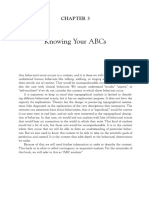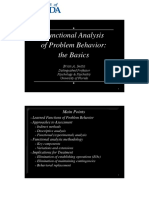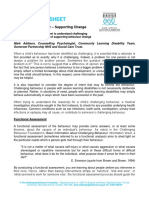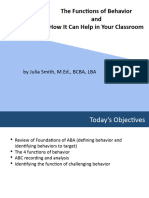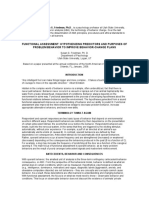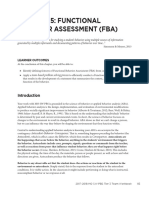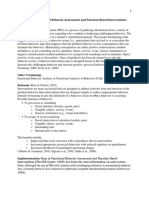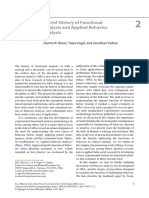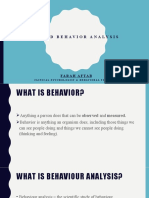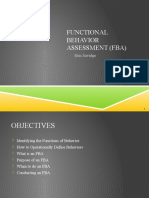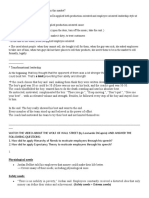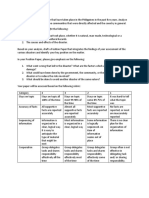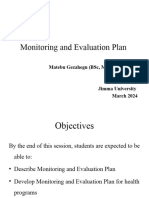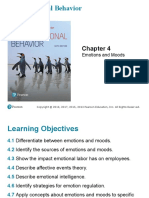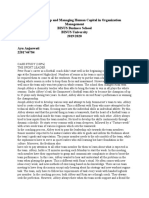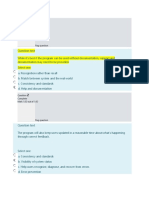Functional Analysis of Behavior
Uploaded by
ScribdTranslationsFunctional Analysis of Behavior
Uploaded by
ScribdTranslationsFunctional analysis of
behavior
https://giphy.com/gifs/areahumana-tendencia-evitativa-personalidad-evitacin-8F9joUFLIieKdi7k8X Melissa P. Sosa Ochoa
Clinical Psychologist - Teacher
OBSERVATION RECORDS
The records, which can take various forms, collect observations of
behaviour (not of people), using parameters (all or part) such as the
following:
Topography: form Latency: time that
(characteristics elapses between the
Intensity (or strength):
and movements) appearance of a
Frequency: number of Duration: amount ofof physical effect that the
stimulus and the
times the behavior timethe
in behavior,
which a behavior produces in
emphasizing the way in beginning of a
occurs in an interval. behavior occurs. [How the environment. [What
which it isitcarried response.
[How many times does long does last?] out. physical effect does it
[What movements [How long does it take
it happen?] produce on the
does for the behavior to
environment?]
the behavior involve?] begin after the stimulus
appears?]
RECORDS
Event logs: Events (
behaviors) Time records:
are recorded as The duration (
Automatic records: Permanent product
they the time it lasts),
Used to records: A permanent
occur. the number of times the
automatically record
Quantitative behavior occurs
motor behaviors and product is tangible and can
procedures may or may in a certain time
physiological
not or interval, the latency (
responses be measured after the
be used: the time elapsed between
through behavior
behaviors the
electronic procedures has
may be counted, or they stimulus and
. occurred [e.g.,
may simply be the behavior) or the time
They are usually used the results of a
described or narrated. between
in laboratories. psychological test]. It is
In the latter case, a behavior and its usually
the records are called repetition are recorded.
“narrative.”
FUNCTIONAL ANALYSIS
What is functional analysis?
In the behavioral model, what is of interest is functionality, that
is, not isolated behavior, but contextualized behavior, paying
special attention to the elements that trigger or reinforce it.
Identify the
antecedent and
consequent variables, Establish the contingency
both external and internal, relationships
that control between
a behavior, a problem such variables and said
or a disorder.
How could functional
analysis be defined then?
Functional Analysis of behavior (FA) is the procedure that allows
establishing the relationships or sequences that characterize a behavior,
specifying the antecedents and consequences that explain why the behavior
occurs and is maintained over time.
What effects or
consequences does it have
on the environment, both in
Under what contextual
the short and
circumstances long term (
( what do others do,
what what benefits or losses
What happens (what stimuli or people does the
does the person think, does it bring
after…).
behavior occur) does the
say, do, feel or how does
he/she react)
Knowing what happens, in what context it occurs and what
effects it has allows us to identify which elements need to be
manipulated to break the sequence of events that make up the
problem.
To break the sequence of events that make up the problem it is
necessary to identify:
Organic variables,
that is, the data of the life
of the person who develops the The
Antecedent stimuli (E), that is, The answer (R) given to the
the stimuli prior to the problem. consequent
problem behavior
problem behavior. stimuli (C).
that can affect it and
the responses that
arise from it.
Antecedent stimuli (E)
They are the triggers for a certain action. These are events that
occur immediately before the emission or appearance of a
problem behavior and that have a functional relationship with it.
They can be:
Internal: cognitive (for
External: physical or social. example, a memory or an
image) or physiological
Organic variables (for example, physical
sensations such as being
fatigued, sleepy, etc.).
They are specific characteristics of each person that can interfere
and contribute to the maintenance of the behavior.
Biological determinants
Repertoire of behaviors
Learning story
Style
Biological determinants
Previous Current
• Correspond to perinatal • They include factors such as
hereditary, factors or illnesses, traumas or transient or
prenatal (anoxia stop) chronic ailments, side or
cardiac, that collateral effects of taking drugs,
appeared but in the fatigue, etc. that alter the
whose pastconsequenc physical or organic balance of
es
are at the time of evaluation. the person.
Their existence can interfere
and maintain the problem, so
they must be taken into account
when of design
he
treatment.
Learning
•It is about of skills and behaviors that •Perhaps the two most relevant variables in
the student possesses and that They will allow us this context are age and way of reasoning.
replace the problem behaviors for Age usually determines whether or not a particular
history
more adaptive behaviors (or approximations one treatment can be applied;
to them). This is perhaps the most important variable to take The way of reasoning conditions the use of
into account. cognitive procedures.
Learning history is understood as the
process of education/socialization that
allowing the acquisition of certain
characteristics that influence in he
behavior of an individual.
•The presence of these variables explains why
different people behave differently when faced with
the same stimuli and the same consequences.
Repertoire
Style
of behaviors
Answers (R)
It is the behavior that the individual performs.
It is necessary to identify which responses or behaviors are subject to modification. And
once identified we must specify the parameters: frequency, duration and
intensity.
Motor response
•Changes that affect the position and •Changes in the physiological constants of that
movement of the organism, its actions (running, organism. These changes in the intensity,
looking, talking, dressing, etc.). They are facts duration or frequency of constants such as
with a beginning and an end that are frequently temperature, degree of skin humidity, heart rate
conditioned and maintained in an operant and respiratory rate, etc. often imply the
manner. presence of a response functionally related to a
•They are also called “external”, they are fact or change in the environment.
observable by anyone and include:
– Motor actions: such as getting up from the bed
chair.
– Verbal behavior: such as a person stuttering
when someone they fear addresses them. –
Non-verbal behavior: such as gestures, tics, etc.
Consequential stimuli (C)
These are the events that take place immediately after
the behavior appears and that have a functional relationship with it,
that is, they cause said behavior to continue.
For example: a child who is disruptive or disruptive in class gets,
on the one hand, the teacher's attention, even if it is to scold him,
and on the other, the attention of his classmates who laugh, so the
child will continue with his disruptive behavior.
Now then…
BACKGROUND STIMULUS (E) ANSWERS (R) CONSEQUENT STIMULUS (C)
Those events or causes that influence What we do
That which occurs as a result of behavior.
behavior.
The student is bored in class He gets up from his place and starts The teacher removes him from class.
bothering his classmates.
Give a talk Najo performance labor
Perform in public Physiological response: either
Starting and maintaining conversations Tachycardia, Palpitations, academic.
blushing, sweating, muscle tension, dry Less social relationships.
mouth, nausea, etc. Fewer friends.
Motor response: Rejection of others.
Drinking alcohol, looking for a place to go Low self-esteem.
unnoticed, escaping the situation with Low mood.
pretexts and excuses, not talking, etc. Increased self-criticism.
Cognitive response:
“I'm going to make a fool of myself”, “I
won't know what to say”, “they'll think I'm
an idiot”, “I'll be blocked”, etc.
And now you build your
functional
analysis…
You might also like
- Analisis Funcional - The ABCs of Human Behavior Cap 3No ratings yetAnalisis Funcional - The ABCs of Human Behavior Cap 314 pages
- Functional Behavior Assesstment and Challenging Behaviors PDF100% (1)Functional Behavior Assesstment and Challenging Behaviors PDF45 pages
- Information Sheet: Challenging Behaviour - Supporting ChangeNo ratings yetInformation Sheet: Challenging Behaviour - Supporting Change11 pages
- Ethical Considerations in Functional Assessment and Treatment Development for Individuals with Special NeedNo ratings yetEthical Considerations in Functional Assessment and Treatment Development for Individuals with Special Need45 pages
- Understanding Autism: Evidence-Based InterventionsNo ratings yetUnderstanding Autism: Evidence-Based Interventions12 pages
- Behavior Therapy and Behavior ModificationNo ratings yetBehavior Therapy and Behavior Modification20 pages
- operant conditioning functional assessmentNo ratings yetoperant conditioning functional assessment11 pages
- The Functional Analysis of Behavior A Practical Guide for Psychotherapy, Social Work, and Counseling Unrestricted Download100% (12)The Functional Analysis of Behavior A Practical Guide for Psychotherapy, Social Work, and Counseling Unrestricted Download14 pages
- For The Purpose of This Essay, I Use The Term Functional Behavioural "Assessment" Rather Than Functional Behavioural "Analysis"No ratings yetFor The Purpose of This Essay, I Use The Term Functional Behavioural "Assessment" Rather Than Functional Behavioural "Analysis"4 pages
- A Brief History of Functional Analysis - An UpdateNo ratings yetA Brief History of Functional Analysis - An Update22 pages
- Functional Behavioural Assessment Information SheetNo ratings yetFunctional Behavioural Assessment Information Sheet1 page
- PSY 3410 Autism Spectrum Disorders & Intellectual DisabilityNo ratings yetPSY 3410 Autism Spectrum Disorders & Intellectual Disability69 pages
- Sensory or Behavior?: Teasing Out Behavioral FunctionsNo ratings yetSensory or Behavior?: Teasing Out Behavioral Functions39 pages
- Tip Sheet: Functional Behavior Assessment and Function-Based InterventionsNo ratings yetTip Sheet: Functional Behavior Assessment and Function-Based Interventions8 pages
- Comparação de metodologias de avaliação funcional- uma síntese quantitativa - 10803-006-0219-6No ratings yetComparação de metodologias de avaliação funcional- uma síntese quantitativa - 10803-006-0219-616 pages
- Behavior Modification: 3rd Class Functional AssessmentNo ratings yetBehavior Modification: 3rd Class Functional Assessment27 pages
- Herscovitch, Roscoe, et al(2009, JABA)(1)No ratings yetHerscovitch, Roscoe, et al(2009, JABA)(1)6 pages
- Resolving Fears, Phobias, and Anxieties: A Guide For Dog GuardiansFrom EverandResolving Fears, Phobias, and Anxieties: A Guide For Dog GuardiansNo ratings yet
- Resolving, Fears, Phobias, and Anxieties: A Manual for ProfessionalsFrom EverandResolving, Fears, Phobias, and Anxieties: A Manual for ProfessionalsNo ratings yet
- Psychoanalysis and The Occult (George Devereux)100% (1)Psychoanalysis and The Occult (George Devereux)444 pages
- Historical Events of The.: Officials and EmployeesNo ratings yetHistorical Events of The.: Officials and Employees115 pages
- Debate I: Basics & Formats: Presented by Doris L. W. ChangNo ratings yetDebate I: Basics & Formats: Presented by Doris L. W. Chang20 pages
- Analysing Movie Posters Educational Presentation in Lilac Red Illustrative StyleNo ratings yetAnalysing Movie Posters Educational Presentation in Lilac Red Illustrative Style29 pages
- CSE PROGRAM_BOOK_FOR_COMMUNITY_SERVICE_PROJECT_-R23No ratings yetCSE PROGRAM_BOOK_FOR_COMMUNITY_SERVICE_PROJECT_-R2343 pages
- (Ebook) My Intense Emotions Handbook by Sue Knowles, Bridie Gallagher and Hannah Bromley ISBN 9781787753839, 1787753832 all chapter instant download100% (1)(Ebook) My Intense Emotions Handbook by Sue Knowles, Bridie Gallagher and Hannah Bromley ISBN 9781787753839, 1787753832 all chapter instant download81 pages
- Couple Therapy for Depression A clinician s guide to integrative practice 1st Edition David Hewison download pdfNo ratings yetCouple Therapy for Depression A clinician s guide to integrative practice 1st Edition David Hewison download pdf84 pages
- Organizational Behavior: Seventeenth Edition0% (1)Organizational Behavior: Seventeenth Edition27 pages
- Mid Exam Leadership and Managing Human Capital in OrganizationNo ratings yetMid Exam Leadership and Managing Human Capital in Organization7 pages
- Migration, Memories, And the Unfinished Partition-pagesNo ratings yetMigration, Memories, And the Unfinished Partition-pages18 pages
- (eBook PDF) Elements of Visual Design in the Landscape 3rd Edition download100% (4)(eBook PDF) Elements of Visual Design in the Landscape 3rd Edition download64 pages
- Question Text: Complete Mark 1.00 Out of 1.00No ratings yetQuestion Text: Complete Mark 1.00 Out of 1.0023 pages






